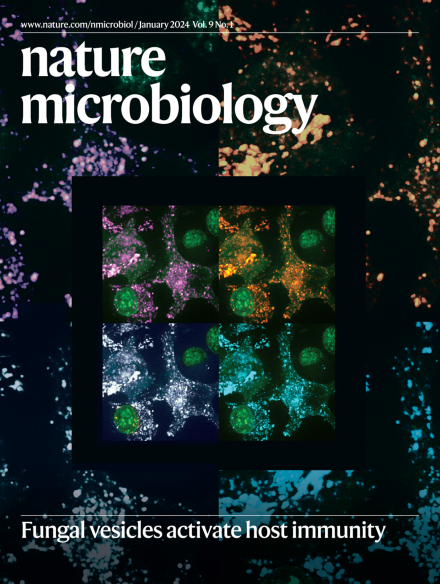拟杆菌科中一个独特的β-桶组装机械复合体的结构。
IF 19.4
1区 生物学
Q1 MICROBIOLOGY
引用次数: 0
摘要
革兰氏阴性β-桶组装机械(BAM)复合物催化新合成的β-桶外膜蛋白的折叠和膜插入。BAM在结构上是保守的,但大多数研究都集中在γ变形杆菌上。在这里,使用单颗粒低温电子显微镜,定量蛋白质组学和功能分析,我们表明BAM复合物在拟杆菌群中是独特的。人类肠道共菌体拟杆菌(3.3 Å)和人类口腔病原体牙龈卟啉单胞菌(3.2 Å)的BAM复合物的低温电镜结构显示出相似的~325 kDa的七组分复合物。这些复合物主要是细胞外的,由典型的BamA和BamA组成;一个完整的、必需的外膜蛋白,BamG,与BamA相关;以及四种表面暴露的脂蛋白:BamH-K。假单胞菌中没有BAM, BamG-K形成一个大的细胞外圆顶,可能赋予额外的功能,使β-桶表面暴露的脂蛋白复合物能够折叠和组装,这是拟杆菌门的标志。我们的发现发展了我们对一个重要细菌门的基本生物学过程的理解。本文章由计算机程序翻译,如有差异,请以英文原文为准。
Structure of a distinct β-barrel assembly machinery complex in the Bacteroidota.
The Gram-negative β-barrel assembly machinery (BAM) complex catalyses the folding and membrane insertion of newly synthesized β-barrel outer membrane proteins. The BAM is structurally conserved, but most studies have focused on Gammaproteobacteria. Here, using single-particle cryogenic electron microscopy, quantitative proteomics and functional assays, we show that the BAM complex is distinct within the Bacteroidota. Cryogenic electron microscopy structures of BAM complexes from the human gut symbiont Bacteroides thetaiotaomicron (3.3 Å) and the human oral pathogen Porphyromonas gingivalis (3.2 Å) show similar, seven-component complexes of ~325 kDa. The complexes are mostly extracellular and comprise canonical BamA and BamD; an integral, essential outer membrane protein, BamG, that associates with BamA; and four surface-exposed lipoproteins: BamH-K. Absent from the BAM in Pseudomonadota, BamG-K form a large, extracellular dome that may confer additional functionality to enable the folding and assembly of β-barrel-surface-exposed lipoprotein complexes that are a hallmark of the Bacteroidota. Our findings develop our understanding of fundamental biological processes in an important bacterial phylum.
求助全文
通过发布文献求助,成功后即可免费获取论文全文。
去求助
来源期刊

Nature Microbiology
Immunology and Microbiology-Microbiology
CiteScore
44.40
自引率
1.10%
发文量
226
期刊介绍:
Nature Microbiology aims to cover a comprehensive range of topics related to microorganisms. This includes:
Evolution: The journal is interested in exploring the evolutionary aspects of microorganisms. This may include research on their genetic diversity, adaptation, and speciation over time.
Physiology and cell biology: Nature Microbiology seeks to understand the functions and characteristics of microorganisms at the cellular and physiological levels. This may involve studying their metabolism, growth patterns, and cellular processes.
Interactions: The journal focuses on the interactions microorganisms have with each other, as well as their interactions with hosts or the environment. This encompasses investigations into microbial communities, symbiotic relationships, and microbial responses to different environments.
Societal significance: Nature Microbiology recognizes the societal impact of microorganisms and welcomes studies that explore their practical applications. This may include research on microbial diseases, biotechnology, or environmental remediation.
In summary, Nature Microbiology is interested in research related to the evolution, physiology and cell biology of microorganisms, their interactions, and their societal relevance.
 求助内容:
求助内容: 应助结果提醒方式:
应助结果提醒方式:


